Intronization Signatures in Coding Exons Reveal the Evolutionary Fluidity of Eukaryotic Gene Architecture
Abstract
:1. Introduction
2. Materials and Methods
2.1. Paramecium Strain and Datasets
2.2. Transcriptomic Data Processing
2.3. Extraction of GT|AG Coding Sequences
2.4. DNA Strand Asymmetry (DSA)
2.5. Quantification of Splicing Events
3. Results
3.1. Intron Properties and Optimal Splice Sites in the Ciliate Paramecium
3.2. Intronization Signature in the Paramecium Genome
3.3. The First Two Phases of the Intronization Process
3.4. Spliced GTA|TAG Coding Sequences Are Unevenly Distributed along the Genes and Genome of Paramecium
3.5. The Final Phase of the Intronization Process
3.6. A Causal Relationship between Intronization and Gene Expression Level Variation?
3.7. Are Some Spliced Coding Sequences on Their Way to Becoming Exons?
3.8. Intronization Promotes Exon Erosion
4. Discussion
Supplementary Materials
Author Contributions
Funding
Data Availability Statement
Conflicts of Interest
References
- Berget, S.M.; Moore, C.; Sharp, P.A. Spliced Segments at 5′ Terminus of Adenovirus 2 Late Messenger-Rna. Proc. Natl. Acad. Sci. USA 1977, 74, 3171–3175. [Google Scholar] [CrossRef] [PubMed]
- Chow, L.T.; Gelinas, R.E.; Broker, T.R.; Roberts, R.J. Amazing Sequence Arrangement at 5′ Ends of Adenovirus-2 Messenger-Rna. Cell 1977, 12, 1–8. [Google Scholar] [CrossRef]
- Gilbert, W. Why Genes in Pieces. Nature 1978, 271, 501. [Google Scholar] [CrossRef] [PubMed]
- Keren, H.; Lev-Maor, G.; Ast, G. Alternative Splicing and Evolution: Diversification, Exon Definition and Function. Nat. Rev. Genet. 2010, 11, 345–355. [Google Scholar] [CrossRef]
- Wilkinson, M.E.; Charenton, C.; Nagai, K. RNA Splicing by the Spliceosome. Annu. Rev. Biochem. 2020, 89, 359–388. [Google Scholar] [CrossRef]
- Maniatis, T.; Reed, R. An Extensive Network of Coupling among Gene Expression Machines. Nature 2002, 416, 499–506. [Google Scholar] [CrossRef]
- Gunderson, S.I.; Polycarpou-Schwarz, M.; Mattaj, I.W. U1 SnRNP Inhibits Pre-MRNA Polyadenylation through a Direct Interaction between U1 70K and Poly(A) Polymerase. Mol. Cell 1998, 1, 255–264. [Google Scholar] [CrossRef]
- Kaida, D.; Berg, M.G.; Younis, I.; Kasim, M.; Singh, L.N.; Wan, L.; Dreyfuss, G. U1 SnRNP Protects Pre-MRNAs from Premature Cleavage and Polyadenylation. Nature 2010, 468, 664–668. [Google Scholar] [CrossRef]
- Berg, M.G.; Singh, L.N.; Younis, I.; Liu, Q.; Pinto, A.M.; Kaida, D.; Zhang, Z.; Cho, S.; Sherrill-Mix, S.; Wan, L.; et al. U1 SnRNP Determines MRNA Length and Regulates Isoform Expression. Cell 2012, 150, 53–64. [Google Scholar] [CrossRef]
- Kaida, D. The Reciprocal Regulation between Splicing and 3′-End Processing. Wiley Interdiscip. Rev. RNA 2016, 7, 499–511. [Google Scholar] [CrossRef] [Green Version]
- Lepennetier, G.; Catania, F. Exploring the Impact of Cleavage and Polyadenylation Factors on Pre-MRNA Splicing Across Eukaryotes. G3 (Bethesda) 2017, 7, 2107–2114. [Google Scholar] [CrossRef] [PubMed]
- Ule, J.; Blencowe, B.J. Alternative Splicing Regulatory Networks: Functions, Mechanisms, and Evolution. Mol. Cell 2019, 76, 329–345. [Google Scholar] [CrossRef] [PubMed]
- Wan, Y.; Larson, D.R. Splicing Heterogeneity: Separating Signal from Noise. Genome Biol. 2018, 19, 86. [Google Scholar] [CrossRef] [PubMed]
- Pickrell, J.K.; Pai, A.A.; Gilad, Y.; Pritchard, J.K. Noisy Splicing Drives MRNA Isoform Diversity in Human Cells. PLoS Genet. 2010, 6, e1001236. [Google Scholar] [CrossRef]
- Tapial, J.; Ha, K.C.H.; Sterne-Weiler, T.; Gohr, A.; Braunschweig, U.; Hermoso-Pulido, A.; Quesnel-Vallières, M.; Permanyer, J.; Sodaei, R.; Marquez, Y.; et al. An Atlas of Alternative Splicing Profiles and Functional Associations Reveals New Regulatory Programs and Genes That Simultaneously Express Multiple Major Isoforms. Genome Res. 2017, 27, 1759–1768. [Google Scholar] [CrossRef]
- Scotti, M.M.; Swanson, M.S. RNA Mis-Splicing in Disease. Nat. Rev. Genet. 2016, 17, 19–32. [Google Scholar] [CrossRef]
- Catania, F.; Lynch, M. Where Do Introns Come From? PLoS Biol. 2008, 6, e283. [Google Scholar] [CrossRef]
- Schmitz, J.; Brosius, J. Exonization of Transposed Elements: A Challenge and Opportunity for Evolution. Biochimie 2011, 93, 1928–1934. [Google Scholar] [CrossRef]
- Catania, F.; Lynch, M. A Simple Model to Explain Evolutionary Trends of Eukaryotic Gene Architecture and Expression: How Competition between Splicing and Cleavage/Polyadenylation Factors May Affect Gene Expression and Splice-Site Recognition in Eukaryotes. Bioessays 2013, 35, 561–570. [Google Scholar] [CrossRef]
- Catania, F. From Intronization to Intron Loss: How the Interplay between MRNA-Associated Processes Can Shape the Architecture and the Expression of Eukaryotic Genes. Int. J. Biochem. Cell Biol. 2017, 91, 136–144. [Google Scholar] [CrossRef]
- Huff, J.T.; Zilberman, D.; Roy, S.W. Mechanism for DNA Transposons to Generate Introns on Genomic Scales. Nature 2016, 538, 533–536. [Google Scholar] [CrossRef] [PubMed]
- Talkish, J.; Igel, H.; Perriman, R.J.; Shiue, L.; Katzman, S.; Munding, E.M.; Shelansky, R.; Donohue, J.P.; Ares, M., Jr. Rapidly Evolving Protointrons in Saccharomyces Genomes Revealed by a Hungry Spliceosome. PLoS Genet. 2019, 15, e1008249. [Google Scholar] [CrossRef] [PubMed]
- Gao, X.; Lynch, M. Ubiquitous Internal Gene Duplication and Intron Creation in Eukaryotes. Proc. Natl. Acad. Sci. USA 2009, 106, 20818–20823. [Google Scholar] [CrossRef] [PubMed]
- Farlow, A.; Meduri, E.; Dolezal, M.; Hua, L.; Schlotterer, C. Nonsense-Mediated Decay Enables Intron Gain in Drosophila. PLoS Genet. 2010, 6, e1000819. [Google Scholar] [CrossRef]
- Lewis, J.D.; Izaurralde, E.; Jarmolowski, A.; McGuigan, C.; Mattaj, I.W. A Nuclear Cap-Binding Complex Facilitates Association of U1 SnRNP with the Cap-Proximal 5′ Splice Site. Genes Dev. 1996, 10, 1683–1698. [Google Scholar] [CrossRef]
- Pabis, M.; Neufeld, N.; Steiner, M.C.; Bojic, T.; Shav-Tal, Y.; Neugebauer, K.M. The Nuclear Cap-Binding Complex Interacts with the U4/U6.U5 Tri-SnRNP and Promotes Spliceosome Assembly in Mammalian Cells. RNA 2013, 19, 1054–1063. [Google Scholar] [CrossRef]
- Colot, H.V.; Stutz, F.; Rosbash, M. The Yeast Splicing Factor Mud13p Is a Commitment Complex Component and Corresponds to CBP20, the Small Subunit of the Nuclear Cap-Binding Complex. Genes Dev. 1996, 10, 1699–1708. [Google Scholar] [CrossRef]
- Crane, M.M.; Sands, B.; Battaglia, C.; Johnson, B.; Yun, S.; Kaeberlein, M.; Brent, R.; Mendenhall, A. In Vivo Measurements Reveal a Single 5′-Intron Is Sufficient to Increase Protein Expression Level in Caenorhabditis Elegans. Sci. Rep. 2019, 9, 9192. [Google Scholar] [CrossRef]
- Le Hir, H.; Nott, A.; Moore, M.J. How Introns Influence and Enhance Eukaryotic Gene Expression. Trends Biochem. Sci. 2003, 28, 215–220. [Google Scholar] [CrossRef]
- Nott, A.; Muslin, S.H.; Moore, M.J. A Quantitative Analysis of Intron Effects on Mammalian Gene Expression. RNA 2003, 9, 607–617. [Google Scholar] [CrossRef] [Green Version]
- Rose, A.B. The Effect of Intron Location on Intron-Mediated Enhancement of Gene Expression in Arabidopsis. Plant J. 2004, 40, 744–751. [Google Scholar] [CrossRef] [PubMed]
- Alekseyenko, A.V.; Kim, N.; Lee, C.J. Global Analysis of Exon Creation versus Loss and the Role of Alternative Splicing in 17 Vertebrate Genomes. RNA 2007, 13, 661–670. [Google Scholar] [CrossRef] [PubMed]
- Lindeboom, R.G.; Supek, F.; Lehner, B. The Rules and Impact of Nonsense-Mediated MRNA Decay in Human Cancers. Nat. Genet. 2016, 48, 1112–1118. [Google Scholar] [CrossRef] [PubMed]
- Longman, D.; Plasterk, R.H.; Johnstone, I.L.; Caceres, J.F. Mechanistic Insights and Identification of Two Novel Factors in the C. Elegans NMD Pathway. Genes Dev. 2007, 21, 1075–1085. [Google Scholar] [CrossRef] [PubMed]
- van Hoof, A.; Green, P.J. Premature Nonsense Codons Decrease the Stability of Phytohemagglutinin MRNA in a Position-Dependent Manner. Plant J. 1996, 10, 415–424. [Google Scholar] [CrossRef]
- Clarke, M.; Lohan, A.J.; Liu, B.; Lagkouvardos, I.; Roy, S.; Zafar, N.; Bertelli, C.; Schilde, C.; Kianianmomeni, A.; Burglin, T.R.; et al. Genome of Acanthamoeba Castellanii Highlights Extensive Lateral Gene Transfer and Early Evolution of Tyrosine Kinase Signaling. Genome Biol. 2013, 14, R11. [Google Scholar] [CrossRef]
- Croll, D.; McDonald, B.A. Intron Gains and Losses in the Evolution of Fusarium and Cryptococcus Fungi. Genome Biol. Evol. 2012, 4, 1148–1161. [Google Scholar] [CrossRef]
- Roy, S.W.; Irimia, M. When Good Transcripts Go Bad: Artifactual RT-PCR “splicing” and Genome Analysis. Bioessays 2008, 30, 601–605. [Google Scholar] [CrossRef]
- Zhan, L.; Meng, Q.; Chen, R.; Yue, Y.; Jin, Y. Origin and Evolution of a New Retained Intron on the Vulcan Gene in Drosophila Melanogaster Subgroup Species. Genome 2014, 57, 567–572. [Google Scholar] [CrossRef]
- Zhu, Z.; Zhang, Y.; Long, M. Extensive Structural Renovation of Retrogenes in the Evolution of the Populus Genome. Plant Physiol. 2009, 151, 1943–1951. [Google Scholar] [CrossRef] [Green Version]
- Kang, L.; Zhu, Z.; Zhao, Q.; Chen, L.; Zhang, Z. Newly Evolved Introns in Human Retrogenes Provide Novel Insights into Their Evolutionary Roles. BMC Evol. Biol. 2012, 12, 128. [Google Scholar] [CrossRef] [PubMed]
- Kim, D.S.; Hahn, Y. Human-Specific Protein Isoforms Produced by Novel Splice Sites in the Human Genome after the Human-Chimpanzee Divergence. BMC Bioinform. 2012, 13, 299. [Google Scholar] [CrossRef]
- Szczesniak, M.W.; Ciomborowska, J.; Nowak, W.; Rogozin, I.B.; Makalowska, I. Primate and Rodent Specific Intron Gains and the Origin of Retrogenes with Splice Variants. Mol. Biol. Evol. 2011, 28, 33–37. [Google Scholar] [CrossRef] [PubMed]
- Zhang, X.H.F.; Chasin, L.A. Comparison of Multiple Vertebrate Genomes Reveals the Birth and Evolution of Human Exons. Proc. Natl. Acad. Sci. USA 2006, 103, 13427–13432. [Google Scholar] [CrossRef] [PubMed]
- Kini, R.M. Accelerated Evolution of Toxin Genes: Exonization and Intronization in Snake Venom Disintegrin/Metalloprotease Genes. Toxicon 2018, 148, 16–25. [Google Scholar] [CrossRef] [PubMed]
- Aury, J.M.; Jaillon, O.; Duret, L.; Noel, B.; Jubin, C.; Porcel, B.M.; Segurens, B.; Daubin, V.; Anthouard, V.; Aiach, N.; et al. Global Trends of Whole-Genome Duplications Revealed by the Ciliate Paramecium Tetraurelia. Nature 2006, 444, 171–178. [Google Scholar] [CrossRef] [PubMed]
- Arnaiz, O.; Mathy, N.; Baudry, C.; Malinsky, S.; Aury, J.M.; Wilkes, C.D.; Garnier, O.; Labadie, K.; Lauderdale, B.E.; Mouel, A.L.; et al. The Paramecium Germline Genome Provides a Niche for Intragenic Parasitic DNA: Evolutionary Dynamics of Internal Eliminated Sequences. PLoS Genet. 2012, 8, e1002984. [Google Scholar] [CrossRef] [PubMed]
- Arnaiz, O.; Van Dijk, E.; Betermier, M.; Lhuillier-Akakpo, M.; de Vanssay, A.; Duharcourt, S.; Sallet, E.; Gouzy, J.; Sperling, L. Improved Methods and Resources for Paramecium Genomics: Transcription Units, Gene Annotation and Gene Expression. BMC Genom. 2017, 18, 483. [Google Scholar] [CrossRef]
- Arnaiz, O.; Meyer, E.; Sperling, L. ParameciumDB 2019: Integrating Genomic Data across the Genus for Functional and Evolutionary Biology. Nucleic Acids Res. 2020, 48, D599–D605. [Google Scholar] [CrossRef]
- Saudemont, B.; Popa, A.; Parmley, J.L.; Rocher, V.; Blugeon, C.; Necsulea, A.; Meyer, E.; Duret, L. The Fitness Cost of Mis-Splicing Is the Main Determinant of Alternative Splicing Patterns. Genome Biol. 2017, 18, 208. [Google Scholar] [CrossRef] [Green Version]
- Didion, J.P.; Martin, M.; Collins, F.S. Atropos: Specific, Sensitive, and Speedy Trimming of Sequencing Reads. PeerJ 2017, 5, e3720. [Google Scholar] [CrossRef] [PubMed]
- Bushnell, B.; Rood, J.; Singer, E. BBMerge—Accurate Paired Shotgun Read Merging via Overlap. PLoS ONE 2017, 12, e0185056. [Google Scholar] [CrossRef] [PubMed]
- Dobin, A.; Davis, C.A.; Schlesinger, F.; Drenkow, J.; Zaleski, C.; Jha, S.; Batut, P.; Chaisson, M.; Gingeras, T.R. STAR: Ultrafast Universal RNA-Seq Aligner. Bioinformatics 2013, 29, 15–21. [Google Scholar] [CrossRef] [PubMed]
- McGrath, C.L.; Gout, J.F.; Johri, P.; Doak, T.G.; Lynch, M. Differential Retention and Divergent Resolution of Duplicate Genes Following Whole-Genome Duplication. Genome Res. 2014, 24, 1665–1675. [Google Scholar] [CrossRef]
- Lepennetier, G.; Catania, F. MRNA-Associated Processes and Their Influence on Exon-Intron Structure in Drosophila Melanogaster. G3 (Bethesda) 2016, 6, 1617–1626. [Google Scholar] [CrossRef]
- Zhang, C.; Li, W.H.; Krainer, A.R.; Zhang, M.Q. RNA Landscape of Evolution for Optimal Exon and Intron Discrimination. Proc. Natl. Acad. Sci. USA 2008, 105, 5797–5802. [Google Scholar] [CrossRef] [PubMed]
- Jaillon, O.; Bouhouche, K.; Gout, J.F.; Aury, J.M.; Noel, B.; Saudemont, B.; Nowacki, M.; Serrano, V.; Porcel, B.M.; Segurens, B.; et al. Translational Control of Intron Splicing in Eukaryotes. Nature 2008, 451, 359–362. [Google Scholar] [CrossRef]
- Bondarenko, V.S.; Gelfand, M.S. Evolution of the Exon-Intron Structure in Ciliate Genomes. PLoS ONE 2016, 11, 161476. [Google Scholar] [CrossRef]
- Gruss, P.; Lai, C.J.; Dhar, R.; Khoury, G. Splicing as a Requirement for Biogenesis of Functional 16S MRNA of Simian Virus 40. Proc. Natl. Acad. Sci. USA 1979, 76, 4317–4321. [Google Scholar] [CrossRef]
- Buchman, A.R.; Berg, P. Comparison of Intron-Dependent and Intron-Independent Gene-Expression. Mol. Cell. Biol. 1988, 8, 4395–4405. [Google Scholar]
- Clark, A.J.; Archibald, A.L.; McClenaghan, M.; Simons, J.P.; Wallace, R.; Whitelaw, C.B. Enhancing the Efficiency of Transgene Expression. Philos. Trans. R. Soc. Lond. Ser. B Biol. Sci. 1993, 339, 225–232. [Google Scholar] [CrossRef]
- Juneau, K.; Miranda, M.; Hillenmeyer, M.E.; Nislow, C.; Davis, R.W. Introns Regulate RNA and Protein Abundance in Yeast. Genetics 2006, 174, 511–518. [Google Scholar] [CrossRef] [PubMed]
- Shabalina, S.A.; Ogurtsov, A.Y.; Spiridonov, A.N.; Novichkov, P.S.; Spiridonov, N.A.; Koonin, E.V. Distinct Patterns of Expression and Evolution of Intronless and Intron-Containing Mammalian Genes. Mol. Biol. Evol. 2010, 27, 1745–1749. [Google Scholar] [CrossRef] [PubMed]
- Furth, P.A.; Choe, W.T.; Rex, J.H.; Byrne, J.C.; Baker, C.C. Sequences Homologous to 5′ Splice Sites Are Required for the Inhibitory Activity of Papillomavirus Late 3′ Untranslated Regions. Mol. Cell. Biol. 1994, 14, 5278–5289. [Google Scholar]
- Brady, H.A.; Wold, W.S. Competition between Splicing and Polyadenylation Reactions Determines Which Adenovirus Region E3 MRNAs Are Synthesized. Mol. Cell. Biol. 1988, 8, 3291–3297. [Google Scholar] [CrossRef]
- Evsyukova, I.; Bradrick, S.S.; Gregory, S.G.; Garcia-Blanco, M.A. Cleavage and Polyadenylation Specificity Factor 1 (CPSF1) Regulates Alternative Splicing of Interleukin 7 Receptor (IL7R) Exon 6. RNA 2013, 19, 103–115. [Google Scholar] [CrossRef]
- Braunschweig, U.; Barbosa-Morais, N.L.; Pan, Q.; Nachman, E.N.; Alipanahi, B.; Gonatopoulos-Pournatzis, T.; Frey, B.; Irimia, M.; Blencowe, B.J. Widespread Intron Retention in Mammals Functionally Tunes Transcriptomes. Genome Res. 2014, 24, 1774–1786. [Google Scholar] [CrossRef]
- Resch, A.; Xing, Y.; Alekseyenko, A.; Modrek, B.; Lee, C. Evidence for a Subpopulation of Conserved Alternative Splicing Events under Selection Pressure for Protein Reading Frame Preservation. Nucleic Acids Res. 2004, 32, 1261–1269. [Google Scholar] [CrossRef]
- Garg, K.; Green, P. Differing Patterns of Selection in Alternative and Constitutive Splice Sites. Genome Res. 2007, 17, 1015–1022. [Google Scholar] [CrossRef]
- Sharp, P.A. Five Easy Pieces. Science 1991, 254, 663. [Google Scholar] [CrossRef]
- Zimmerly, S.; Semper, C. Evolution of Group II Introns. Mob. DNA 2015, 6, 7. [Google Scholar] [CrossRef] [PubMed]
- Senapathy, P. Origin of Eukaryotic Introns—A Hypothesis, Based on Codon Distribution Statistics in Genes, and Its Implications. Proc. Natl. Acad. Sci. USA 1986, 83, 2133–2137. [Google Scholar] [CrossRef] [PubMed] [Green Version]
- Rogers, J.H. How Were Introns Inserted into Nuclear Genes. Trends Genet. 1989, 5, 213–216. [Google Scholar] [CrossRef]
- Dibb, N.J. Proto-Splice Site Model of Intron Origin. J. Theor. Biol. 1991, 151, 405–416. [Google Scholar] [CrossRef]
- Dibb, N.J.; Newman, A.J. Evidence That Introns Arose at Proto-Splice Sites. EMBO J. 1989, 8, 2015–2021. [Google Scholar] [CrossRef] [PubMed]
- Catania, F.; Schmitz, J. On the Path to Genetic Novelties: Insights from Programmed DNA Elimination and RNA Splicing. Wiley Interdiscip. Rev. RNA 2015, 6, 547–561. [Google Scholar] [CrossRef]
- McGuire, A.M.; Pearson, M.D.; Neafsey, D.E.; Galagan, J.E. Cross-Kingdom Patterns of Alternative Splicing and Splice Recognition. Genome Biol. 2008, 9, R50. [Google Scholar] [CrossRef]
- Robberson, B.L.; Cote, G.J.; Berget, S.M. Exon Definition May Facilitate Splice Site Selection in RNAs with Multiple Exons. Mol. Cell. Biol. 1990, 10, 84–94. [Google Scholar]
- Talerico, M.; Berget, S.M. Effect of 5′ Splice Site Mutations on Splicing of the Preceding Intron. Mol. Cell. Biol. 1990, 10, 6299–6305. [Google Scholar]
- Sterner, D.A.; Carlo, T.; Berget, S.M. Architectural Limits on Split Genes. Proc. Natl. Acad. Sci. USA 1996, 93, 15081–15085. [Google Scholar] [CrossRef]
- Li, X.; Liu, S.; Zhang, L.; Issaian, A.; Hill, R.C.; Espinosa, S.; Shi, S.; Cui, Y.; Kappel, K.; Das, R.; et al. A Unified Mechanism for Intron and Exon Definition and Back-Splicing. Nature 2019, 573, 375–380. [Google Scholar] [CrossRef] [PubMed]
- Rahman, S.; Kosakovsky Pond, S.L.; Webb, A.; Hey, J. Weak Selection on Synonymous Codons Substantially Inflates DN/DS Estimates in Bacteria. Proc. Natl. Acad. Sci. USA 2021, 118, e2023575118. [Google Scholar] [CrossRef] [PubMed]
- Lynch, M. Intron Evolution as a Population-Genetic Process. Proc. Natl. Acad. Sci. USA 2002, 99, 6118–6123. [Google Scholar] [CrossRef]
- Roy, S.W.; Gilbert, W. The Evolution of Spliceosomal Introns: Patterns, Puzzles and Progress. Nat. Rev. Genet. 2006, 7, 211–221. [Google Scholar]
- Lynch, M.; Conery, J.S. The Origins of Genome Complexity. Science 2003, 302, 1401–1404. [Google Scholar] [CrossRef] [PubMed] [Green Version]
- Lynch, M. The Origins of Genome Architecture; Sinauer Associates: Sunderland, MA, USA, 2007. [Google Scholar]
- Csuros, M.; Rogozin, I.B.; Koonin, E.V. A Detailed History of Intron-Rich Eukaryotic Ancestors Inferred from a Global Survey of 100 Complete Genomes. PLoS Comput. Biol. 2011, 7, 1002150. [Google Scholar] [CrossRef] [Green Version]
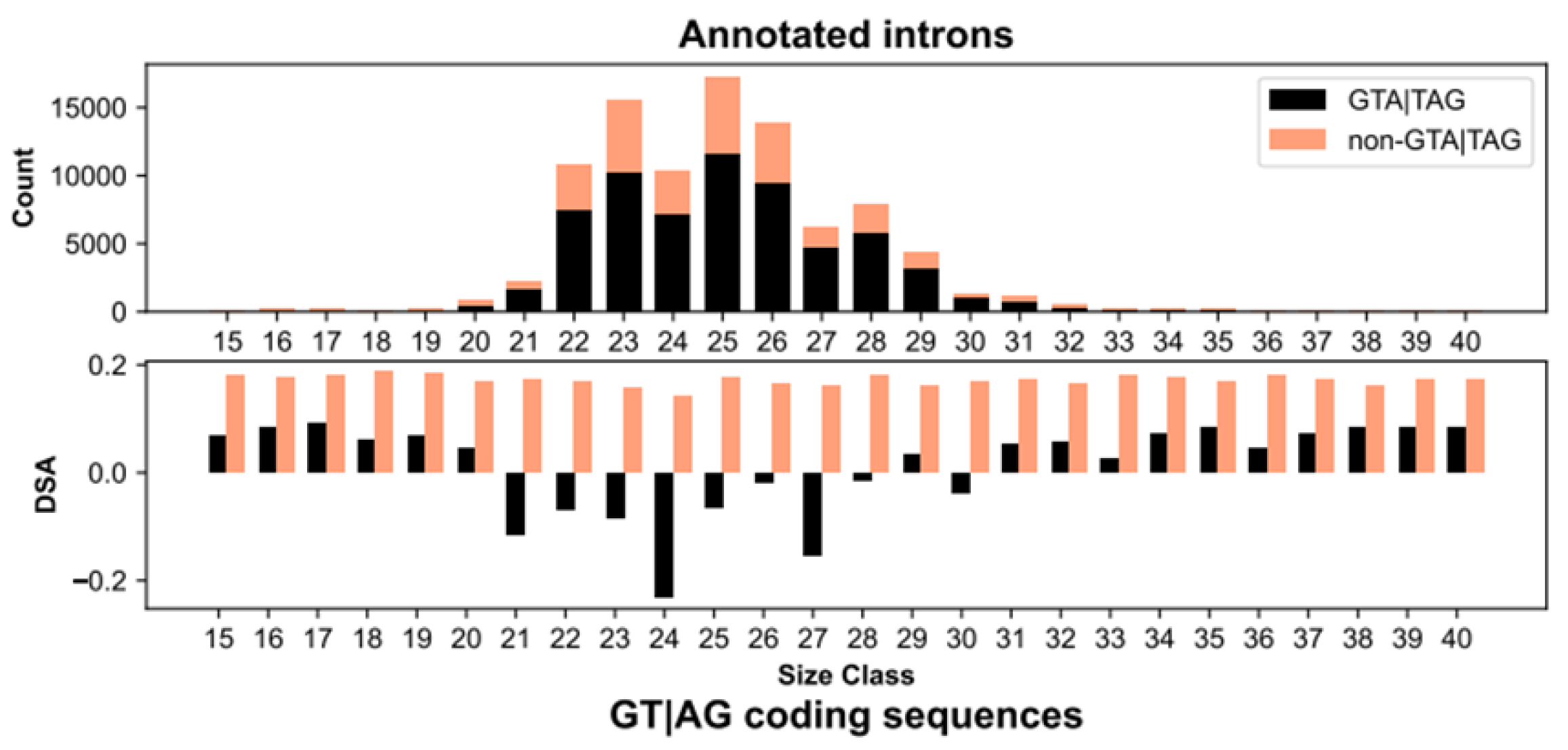
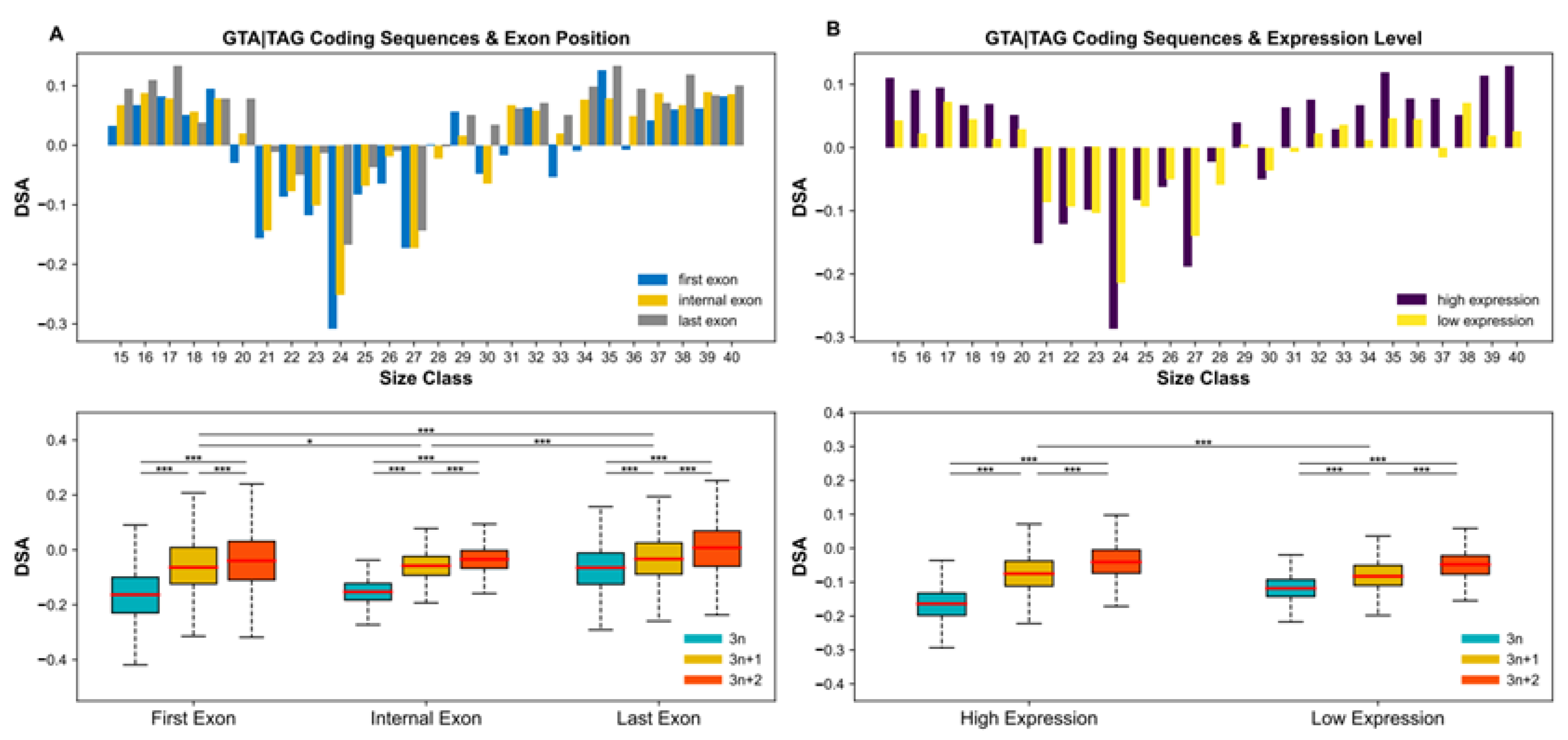

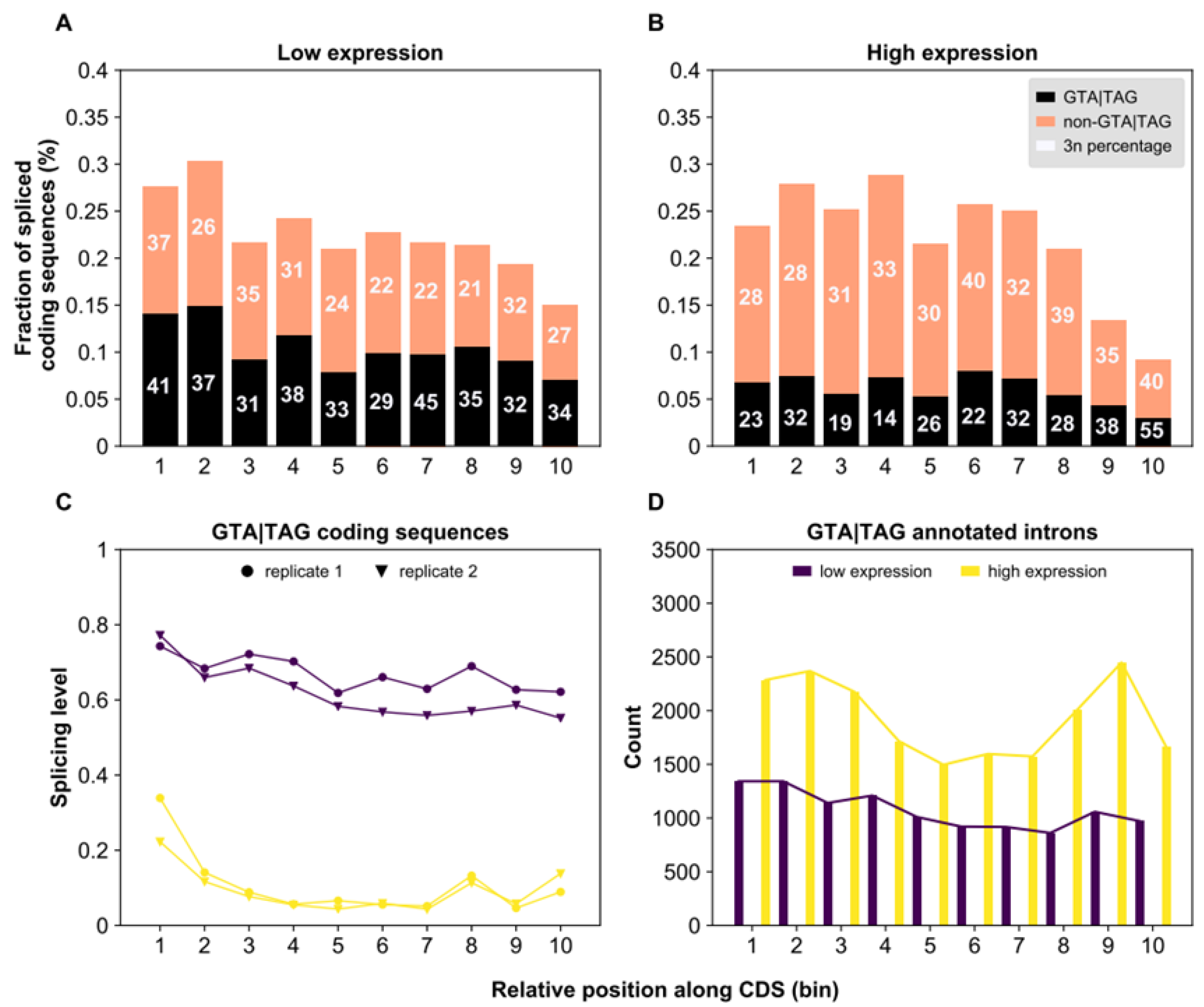
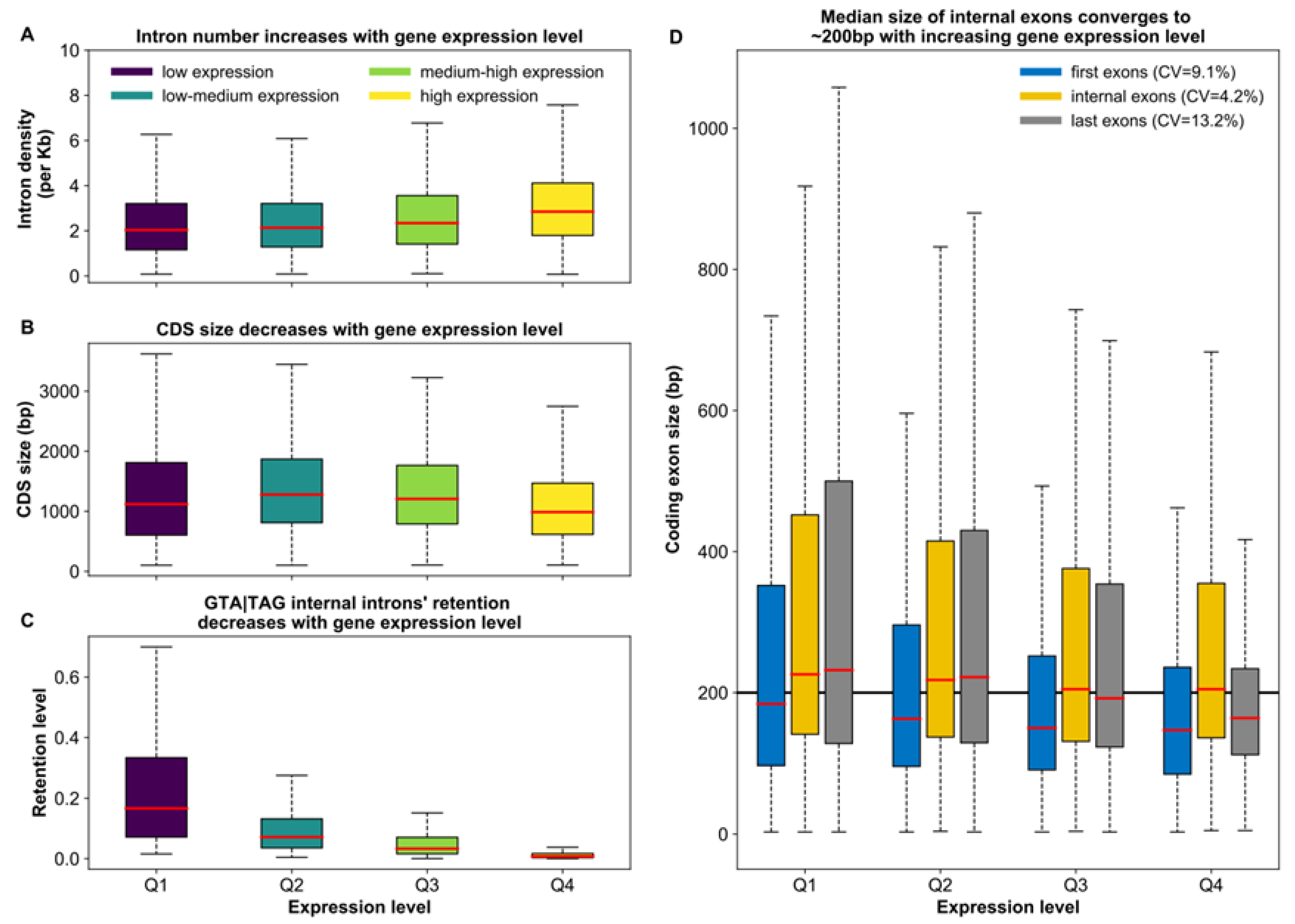


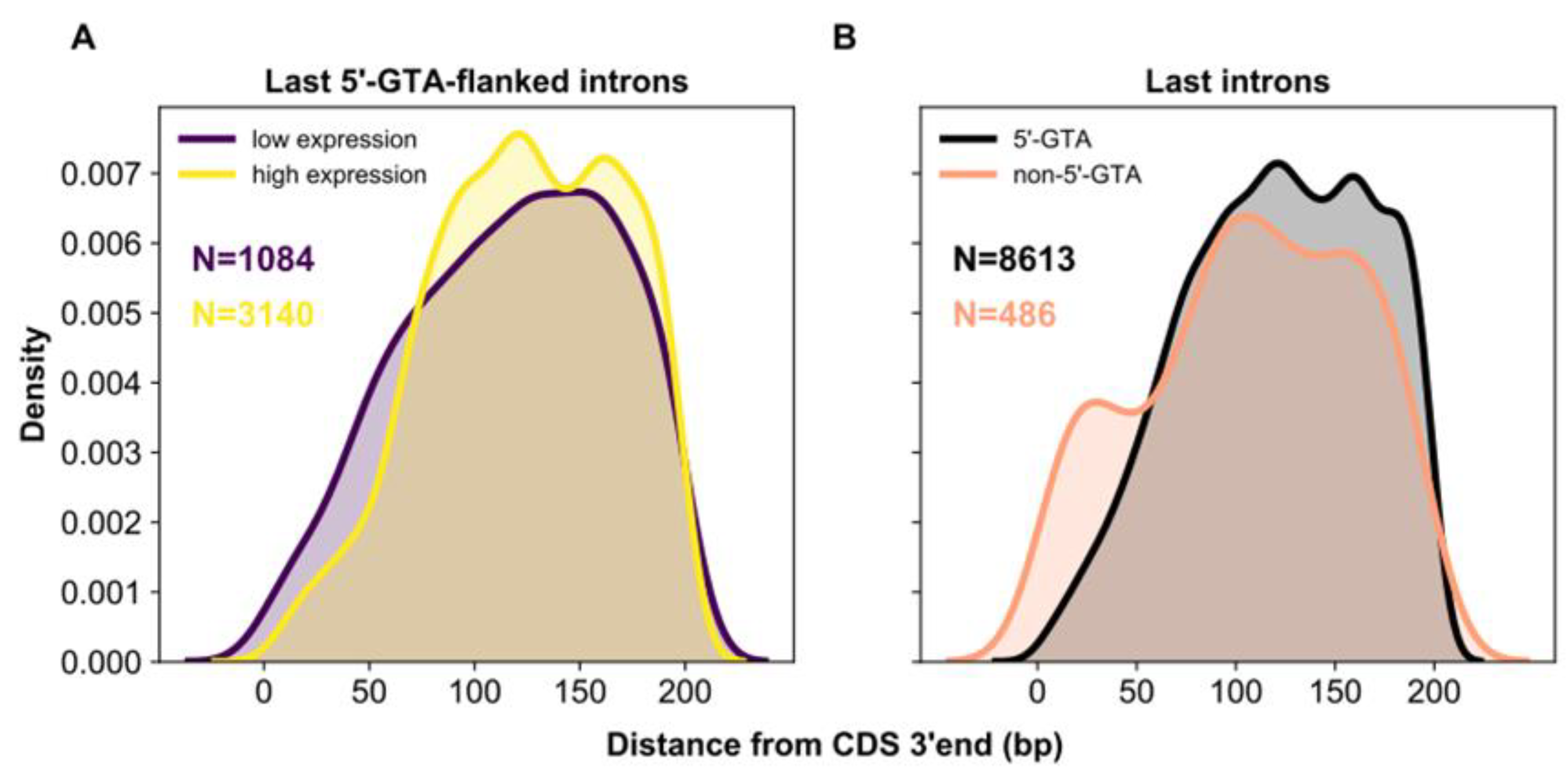

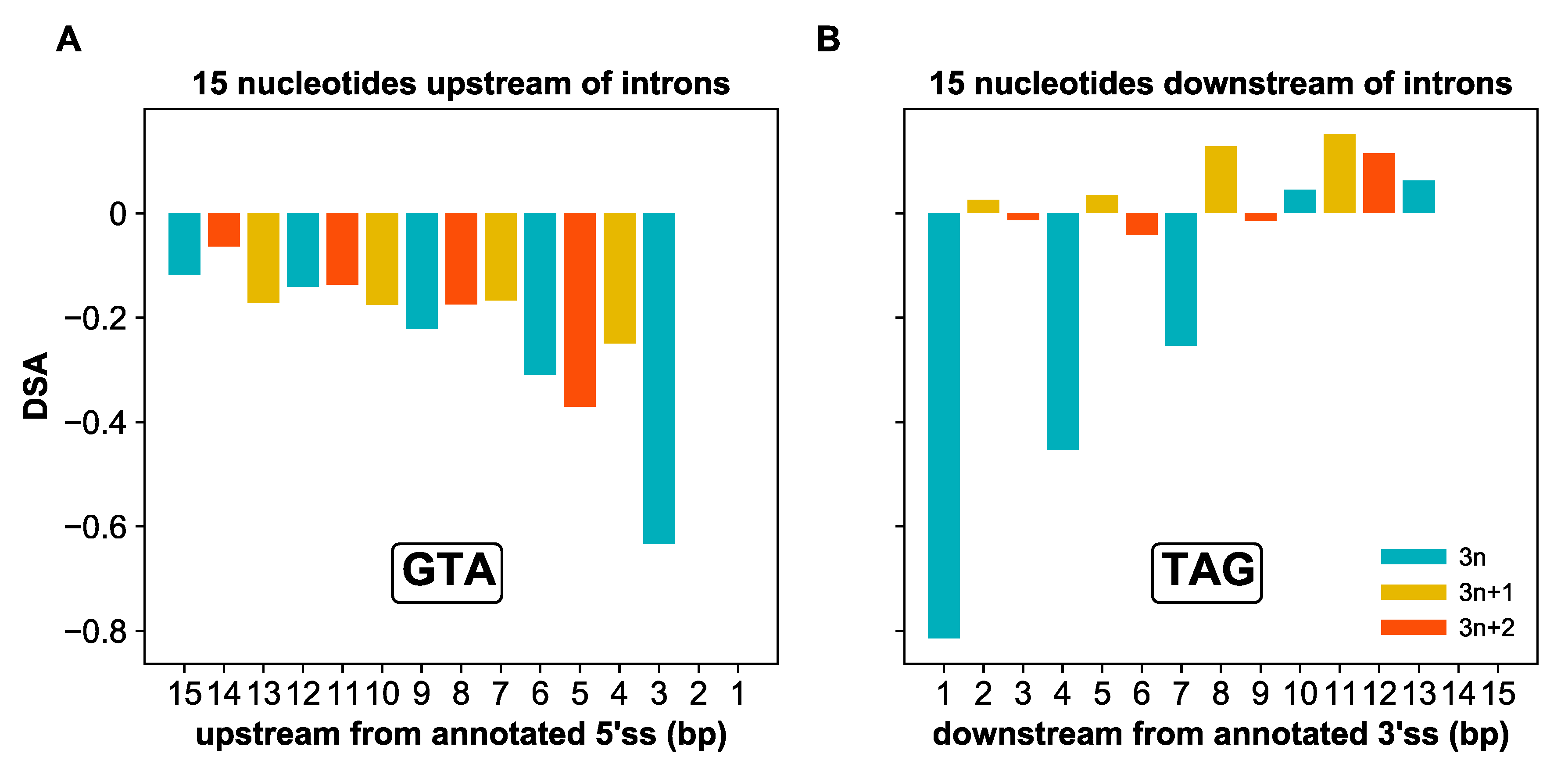
| Splice Sites | Expression Level | |||
|---|---|---|---|---|
| Low | Medium Low | Medium High | High | |
| GTA-TAG | 65.5 | 66.9 | 69.3 | 72.6 |
| GTA-nAG | 91.8 | 94.0 | 94.7 | 94.9 |
| GTn-TAG | 70.5 | 71.3 | 73.4 | 76.5 |
Publisher’s Note: MDPI stays neutral with regard to jurisdictional claims in published maps and institutional affiliations. |
© 2022 by the authors. Licensee MDPI, Basel, Switzerland. This article is an open access article distributed under the terms and conditions of the Creative Commons Attribution (CC BY) license (https://creativecommons.org/licenses/by/4.0/).
Share and Cite
Ryll, J.; Rothering, R.; Catania, F. Intronization Signatures in Coding Exons Reveal the Evolutionary Fluidity of Eukaryotic Gene Architecture. Microorganisms 2022, 10, 1901. https://doi.org/10.3390/microorganisms10101901
Ryll J, Rothering R, Catania F. Intronization Signatures in Coding Exons Reveal the Evolutionary Fluidity of Eukaryotic Gene Architecture. Microorganisms. 2022; 10(10):1901. https://doi.org/10.3390/microorganisms10101901
Chicago/Turabian StyleRyll, Judith, Rebecca Rothering, and Francesco Catania. 2022. "Intronization Signatures in Coding Exons Reveal the Evolutionary Fluidity of Eukaryotic Gene Architecture" Microorganisms 10, no. 10: 1901. https://doi.org/10.3390/microorganisms10101901
APA StyleRyll, J., Rothering, R., & Catania, F. (2022). Intronization Signatures in Coding Exons Reveal the Evolutionary Fluidity of Eukaryotic Gene Architecture. Microorganisms, 10(10), 1901. https://doi.org/10.3390/microorganisms10101901





